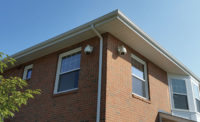Using Intercoms to Protect Vulnerable Families

Six duplexes in Des Moines, Iowa, have been renovated and turned into transitional housing for young homeless parents. Through the application of security technology – such as card access control, door and window alarms and a two-way intercom system – the Lighthouse Transitional Living Program is helping transition-age youths prepare for independent living. Photo courtesy of Toby O’Berry, Iowa Homeless Youth Centers
For transition-age youth (16-25), the Lighthouse Transitional Living Program can be a vital lifeline. Part of the Iowa Homeless Youth Centers based in Des Moines, this program recently purchased and renovated six duplexes in a cul-de-sac, updating the security and amenities to create a more stable, independent living situation for homeless parents, pregnant young mothers and other at-risk youths.
According to Lighthouse’s director, Toby O’Berry, the voluntary program’s previous housing option was more similar to a dormitory than independent living, and residents would need to be let into the building by staff every day. In the new duplexes, residents have card access to their units, which is monitored from the on-site community center (situated in one of the six duplexes owned by the program). Using the Sielox Pinnacle card access control system instead of physical keys means that it’s easier and less expensive to deactivate a card than re-key a unit if a program participant were to leave abruptly or under unpleasant circumstances, and they can come and go from their residence as needed without the program’s staff losing oversight.
Surveillance cameras were also installed outside the units, and staff in the community center can also monitor when doors or windows are opened through time-zoned door and window alarms, lest children wander out unnoticed. Staff members can check in with the residents via two-way intercoms, which are installed in every unit.
Instead of relying on residents’ own cellphones – which are not always working or available – or landlines, the intercoms let Lighthouse staff stay in touch with residents without being overbearing or cost-prohibitive, O’Berry says.
The intercoms enable program participants to reach out for help and to get messages. A young mom could call the community center for advice from a childcare specialist, or a staff member could send a message out to all units regarding a free meal, upcoming parenting classes or information about an emergency or impending weather event.
“We have an interesting dynamic here with security,” says O’Berry. “We want to provide safety and oversight without being overbearing… People can be in the program for two years for free, getting life counselling and help; we want the system to give them as much mobility as possible to come and go, but with oversight and support to help them.”
Through this program, and the safety that the system enables, 95 percent of the youth who enter this residential program exit to safe housing, says O’Berry.
Looking for a reprint of this article?
From high-res PDFs to custom plaques, order your copy today!





